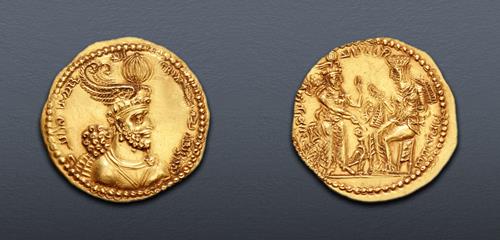|
KUSHANO-SASANIANS. Ohrmazd (Hormizd) II. Circa AD 300-303. AV Dinar (31mm, 8.01 g, 12h). Investiture Issue. Unnamed (Boxlo [Balkh]) mint. mzdysn bgy ‘whrmzdy RB’ kws’n mlk’ in Pahlavi, bust right, wearing winged crown with ribbons and surmounted by pomegranate / ‘w’ppy [= blundered ‘pzt’] mlk’ ‘whrmzdy in Pahlavi, Ohrmazd, with eagle at feet, standing right, holding smoking censer in right hand and raising left hand in gesture of benediction to Anahita to Anahita enthroned left, holding investiture wreath in raised right hand and scepter in left. Unpublished in the standard references. Deposits in devices, a hint of smoothing in fields, traces of die rust, reverse slightly double struck. EF. Extremely rare, none in CoinArchives.
The ceremony of investiture was a significant moment in the rule of the Sasanian monarch (and, by extension, those who ruled on his behalf), since it bestowed both legal and spiritual legitimacy on his rule. As a part of the process, the various Sasanian kings ordered this event to be proclaimed in rock carvings, such as Bahrām I (AD 273-76) at Bišāpur, and Narseh (AD 292-303) at Naqš-e Rostam. Shāhpur I (240-72) was one of the rare exceptions, since he recorded his investiture both at Naqš-e Rajab and Bišāpur. The ceremony itself was filled with deep religious symbolism: the goddess Anahita, an important divinity in the Iranian pantheon, was closely associated with the ceremony, as was the fire-altar, which was central to Zoroastrianism. As part of the ceremony, the ruler received the diadem, signifying their right to rule, as well as a personalized crown. This crown had a specialized significance: it distinguished the monarch as a unique ruler with the divine blessing for rule.
This investiture ceremony was the same for the Kushanshas (or Kushano-Sasanians), who ruled those parts of the former Kushan Empire now under Sasanian control. Like the Sasanians, each Kushanshah ruler had his own personal crown (see M. Carter. “A Numismatic Reconstruction of Kushano-Sasanian History” in AMNSMN 30 [1985]). It appears that their Sasanian overlords allowed these Kushanshahs to mint coins proclaiming their investiture. To date, most of these issues are silver drachms in public collections, or have very rarely appeared at auction (see Triton XXII, lot 486 for a drachm of Pērōz [Fīrūz]) I Kushanshah and E. Errington and V. Sarkhosh Curtis, From Persepolis to the Punjab [London, 2007], fig. 74.12 for a drachm of Ohrmazd [Hormizd] I). The same is the case with the extremely rare dinar of Ohrmazd (Hormizd) II (see lot 621 above)
This dinar is unusual, since it is the only known example that diverts from the standard Kushano-Sasanian dinar obverse iconography. Instead, it derives from from the obverse type known for Kushano-Sasanian drachms: a crowned bust and legend in Pahlavi, rather than the more regular Bactrian. Like lot 621, this dinar shows the personal crown worn Ohrmazd (Hormizd), which again appears in the reverse design. More research may elucidate how this issue fits into the coinage of the Kushano-Sasanians.
The final winners of all Triton XXV lots will be determined at the live public sale that will be held on 11-12 January 2022. Triton XXV – Session Two – Greek Coinage (Part 2) through Roman Provincial Coinage will be held Tuesday afternoon, 11 January 2022 beginning at 2:00 PM ET.
Winning bids are subject to a 20% buyer's fee for bids placed on this website and 22.50% for all others.
We recognize that our users may have various Internet Browsers and Operating Systems. We like our visitors to have the best possible experience when using our bidding platform. However, we do recognize that it is impossible to develop applications that work identically, efficiently and effectively on all web browsers. The CNG bidding platform supports the latest stable major version and the stable previous version of Mozilla Firefox and Chrome.
|
